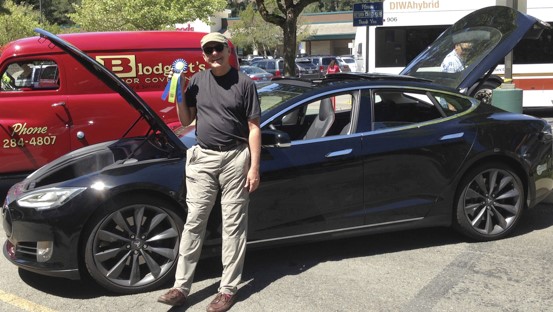Mad Hedge Technology Letter
May 25, 2018
Fiat Lux
Featured Trade:
(WHERE 5G CONNECTIVITY WILL TAKE US),
(T), (VZ), (INTC), (TSLA), (AAPL), (GOOGL)
AT&T (T), Verizon (VZ), and the other telecom heavies are in the process of investing $30 billion to make sure that fifth-generation wireless, or 5G, will roll out on time in 2020.
What 5G will do is improve the functionality of IoT (Internet of Things) by 10 times at one-tenth the cost, bringing a 100X increase of functionality over price.
The last time I saw a leap that great was when Intel (INTC) brought out its groundbreaking 8008 8-bit microprocessor chip in 1972. I remember it like it was yesterday.
The news that gravitational waves were discovered, as well as wrinkles in the space-time continuum, was big news in my family. 5G will be of that order.
Of course, we knew it was coming. It was just a matter of when.
I have 11- and 13-year-old girls (I can't help it if the plumbing still works!). Whenever we drive somewhere, we carry out what Einstein called "thought experiments."
They will come up with scientific questions, and I then direct them into finding their own answers through a series of prodding and hopeful questions.
It is much like how the children of royalty were tutored during the Middle Ages.
So they asked, "When will we get driverless cars?" which they had heard about on TV.
I answered in about two years, but that I had friends who run Tesla (TSLA) who already have them now.
And you know the interesting thing they discovered? After two years of beta testing, the cars are starting to develop their own personalities.
Each car has highly advanced learning software. When the mapping software requires one to take a difficult sharp left turn, the vehicle may miss it the first time.
It will then make the next legal U-turn, and then nail that turn every time in the future.
The cars are all programmed to drive like little old ladies. It will never speed, break the law, and always lets other cars cut in front. Over time, some are becoming cautious, while others are getting more aggressive depending on each individual's driving experience.
In other words, experience is turning them into "people."
I asked my daughters, "What would the world be like if everyone had driverless cars?" which will occur in about 30 years, or during their middle age.
They pondered for a moment. Then my older daughter shouted out, "There won't be car accidents anymore!" "Right!" I answered.
"But what will that mean?" I asked.
They puzzled over this.
A few seconds passed. Then it came. "The people who fix cars won't have anything to do!"
"You got it," I replied.
In fact, about 1 million people in the car repair industry will lose their jobs. A small group of vintage car fanatics will survive, much like horse and buggy hobbyists do today.
I pointed out that this is already happening because electric cars don't require any maintenance. You just rotate the tires every 6,000 miles (because electric batteries are so heavy).
I moved on. "Who else will lose their jobs when cars become self-driving?" They hit a brick wall. Then I asked "What else breaks when cars have accidents?"
A few seconds later it came. "People!"
"For sure," I shot back.
Actually, about 35,000 people die in car accidents every year in the United States, and another 500,000 are injured.
This means the demand for doctors, hospitals, and ambulances will go down. Say goodbye to another 1 million jobs.
"So, what else will self-driving cars do?" I was relentless.
My older girl was first: "If cars are driven by computers, it means they can drive closer together." I said, "That was true, but what was the consequence of that?"
The mountain scenery whizzed by. Then they got it.
"There won't be traffic jams anymore."
"Yes!" I blurted out. If a car can drive 70 miles per hour, but only needs to remain one car length behind the one in front of it, that effectively increases the capacity of freeways seven times.
We will never need to build another freeway again. Another 1 million jobs go down the drain.
"What else will self-driving cars do?" I carried on.
They hit a dead end. So, I gave a hint. "What do you see in cities?" After going through buildings, parks, roads, lots of cars, and bridges, I finally got the answer I wanted: "Parking lots."
I then posed the conundrum, "What's the connection between self-driving cars and parking lots?"
Now they were getting into the spirit of the thing. "They won't need them." I replied, "Absolutely."
Self-driving cars won't need to park. They'll just be able to drop you off and drive around the block until you are ready to go home.
This will be economical because after three decades of battery and solar improvements, energy will effectively be free, like air is today.
Oh, and at least 100,000 parking attendants might as well start joining the unemployment lines now.
It gets better.
Entrepreneurs now are developing apps for cars so they never need to park.
In an iteration of the sharing economy, and in a club or membership type format, your car will just drive person to person, selling rides, until you are ready to go home.
Think of it as Uber, without the drivers, that pays you.
Today, parking lots occupy about 15% of the land area of large cities. Self-driving cars will free up a lot of that space for other uses, such as housing and parks.
Then I asked the really big question. "What do all of these changes have in common?"
My 11-year-old picked up on this immediately. "A lot of people are going to lose their jobs!"
"For sure," I bubbled. Notice that every new technology improvement creates a lot of job losses. I went on.
"The trick for you girls is to always stay ahead of the technology curve so your job doesn't get lost, too." This is why I have been sending them to Java development school since they were 8 and 9.
They looked daunted.
And this is what 11- and 13-year-olds were able to figure out. Granted, they were MY kids.
Imagine what Google (GOOGL), Apple (AAPL), and Tesla are doing with this idea. It has become a hot bottom "next big thing." Silicon Valley is now rife with rumors of breakthrough developments and the poaching of staff.
The U.S. military and the Defense Advanced Research Projects Agency (DARPA) are involved in self-driving vehicles in a big way as well, holding regular contests with big prize money and the prospect of mammoth government contracts.
More and more generals and admirals are telling me that the wars of the future will be fought with software.
The bottom line is that things are happening much faster than we imagined possible only a few years ago.
Then my oldest daughter piped up.
"Dad, can I get my driver's license before all the cars are self-driving?" I said, "Sure. What kind of car do you want?"
"A red one."
My first car was a red 1957 Volkswagen Beetle.
On our next trip we will cover gravitational waves, Einstein's Theory of Relativity, and the significance of the clock tower in Bern, Switzerland.
By the way, these girls will be graduating from college in 2026 and 2027 and will be looking for jobs.
Just let me know. :-)
_________________________________________________________________________________________________
Quote of the Day
"Homo sapiens, the first truly free species, is about to decommission the natural selection, the force that made us," said E.O. Wilson, a Harvard University biology professor.
While the Diary of a Mad Hedge Fund Trader focuses on investment over a one week to six-month time frame, Mad Day Trader, provided by Bill Davis, will exploit money-making opportunities over a brief ten minute to three day window. It is ideally suited for day traders, but can also be used by long-term investors to improve market timing for entry and exit points. Read more
While the Diary of a Mad Hedge Fund Trader focuses on investment over a one week to six-month time frame, Mad Day Trader, provided by Bill Davis, will exploit money-making opportunities over a brief ten minute to three day window. It is ideally suited for day traders, but can also be used by long-term investors to improve market timing for entry and exit points. Read more
Global Market Comments
May 24, 2018
Fiat Lux
Featured Trade:
(FRIDAY, JULY 27, 2018, ZERMATT, SWITZERLAND GLOBAL STRATEGY SEMINAR),
(ANNOUNCING THE MAD HEDGE TESTIMONIAL CONTEST),
(THE SECRET FED PLAN TO BUY GOLD),
(GLD), (GDX), (PALL), (PPLT)
Come join me for afternoon tea at the Mad Hedge Fund Trader's Global Strategy Seminar, which I will be conducting high in the Alps in Zermatt, Switzerland at 2:00 PM on Friday, July 27, 2018.
An open discussion on the crucial issues facing investors today will take place. Coffee, tea, and schnapps will be made available, but no food. You are welcome to attend in your mountain climbing gear, if necessary. One year, a guest descended from the Matterhorn summit to attend.
I'll be giving you my up-to-date view on stocks, bonds, foreign currencies, commodities, precious metals, energy, and real estate. And to keep you in suspense, I'll be throwing a few surprises out there, too. Tickets are available for $220.
I'll be arriving early and leaving late in case anyone wants to have a one-on-one discussion, or just sit around and chew the fat about the financial markets.
The event will be held at a central Zermatt hotel with a great Matterhorn view, the details of which will be emailed directly to you with your purchase confirmation.
I look forward to meeting you and thank you for supporting my research.
To purchase tickets please click here.
How would you like to win a free one-year subscription to the Diary of a Mad Hedge Fund Trader?
We are looking for video testimonials from subscribers who have had a blowout success with our service. A duration of one or two minutes is fine. The more specifics you mention the better, such as outlining the individual stock or asset class you bought and how much money you made from it.
You can simply do this with the video camera on your computer or smart phone. Just keep a steady hand so viewers won't get seasick.
First prize is a one-year extension of your existing subscription to a Mad Hedge Fund Trader service, second prize is six months, and third prize is three months. The winners will be posted on my website at a future date.
The deadline is June 15, 2018. To email a video you will need to use a large file transfer app, such as Drobox or Hightail, or send them via Google Docs. Just put "Video Testimonial Contest" in the subject line.
I can't wait to see what comes back.
John Thomas
CEO & Publisher
The Diary of a Mad Hedge Fund Trader
Mad Hedge Technology Letter
May 24, 2018
Fiat Lux
Featured Trade:
(MICRON'S BLOCKBUSTER SHARE BUYBACK)
(MU), (AMZN), (NFLX), (AAPL), (SWKS), (QRVO), (CRUS), (NVDA), (AMD)
The Amazon (AMZN) and Netflix (NFLX) model is not the only technology business model out there.
Micron (MU) has amply proved that.
Bulls were dancing in the streets when Micron announced a blockbuster share buyback of $10 billion starting in September.
This is all from a company that lost $276 million in 2016.
The buyback is an overwhelmingly bullish premonition for the chip sector that should be the lynchpin to any serious portfolio.
The news keeps getting better.
Micron struck a deal with Intel to produce chips used in flash drives and cameras. Every additional contract is a feather in its cap.
The share repurchase adds up to about 16% of its market value and meshes nicely with its choreographed road map to return 50% of free cash flow to shareholders.
Tech's weighting in the S&P has increased 3X in the past 10 years.
To put tech's strength into perspective, I will roll off a few numbers for you.
The whole American technology sector is worth $7.3 trillion, and emerging markets and European stocks are worth $5 trillion each.
Tech is not going away anytime soon and will command a higher percentage of the S&P moving forward and a higher multiple.
The $5 billion in profit Micron earned in 2017 was just the start and sequential earnings beats are part of their secret sauce and a big reason why this name has been one of the cornerstones of the Mad Hedge Technology Letter portfolio since its inception as well as the first recommendation at $41 on February 1.
Did I mention the stock is dirt cheap at a forward PE multiple of just 6 and that is after a 35% rise in the share price so far this year?
What's more, putting ZTE back into business is a de-facto green light for chip companies to continue sales to Chinese tech companies.
China consumed 38% of semiconductor chips in 2017 and is building 19 new semiconductor fabrication plants (FAB) in an attempt to become self-sufficient.
This is part of its 2025 plan to jack up chip production from less than 20% of global share in 2015 to 70% in 2025.
This is unlikely to happen.
If it was up to them, China would dump cheap chips to every corner of the globe, but the problem is the lack of innovation.
This is hugely bullish for Micron, which extracts half of its revenue from China. It is on cruise control as long as China's nascent chip industry trails miles behind them.
At Micron's investor day, CFO David Zinsner elaborated that the mammoth buyback was because the stock price is "attractive" now and further appreciation is imminent.
Apparently, management was in two camps on the capital allocation program.
The two choices were offering shareholders a dividend or buying back shares.
Management chose share repurchases but continued to say dividends will be "phased in."
This is a company that is not short on cash.
The free cash flow generation capabilities will result in a meaningful dividend sooner than later for Micron, which is executing at optimal levels while its end markets are extrapolating by the day.
As it stands today, Micron is in the midst of taking its 2017 total revenue of about $20 billion and turning it into a $30 billion business by the end of 2018.
Growth - Check. Accelerating Revenue - Check. Margins - Check. Earnings beat - Check. Guidance hike - Check.
The overall chips market is as healthy as ever and data from IDC shows total revenues should grow 7.7% in 2018 after a torrid 2017, which saw a 24% bump in revenues.
The road map for 2019 is murkier with signs of a slowdown because of the nature of semi-conductor production cycles. However, these marginal prognostications have proved to be red herrings time and time again.
Each red herring has offered a glorious buying opportunity and there will be more to come.
Consolidation has been rampant in the chip industry and shows no signs of abating.
Almost two-thirds of total chip revenue comes from the largest 10 chip companies.
This trend has been inching up from 2015 when the top 10 comprised 53% in 2016 and 56% in 2017.
If your gut can't tell you what to buy, go with the bigger chip company with a diversified revenue stream.
The smaller players simply do not have the cash to splurge on cutting-edge R&D to keep up with the jump in innovation.
The leading innovator in the tech space is Nvidia, which has traded back up to the $250 resistance level and has fierce support at $200.
Nvidia is head and shoulders the most innovative chip company in the world.
The innovation is occurring amid a big push into autonomous vehicle technology.
Some of the new generation products from Nvidia have been worked on diligently for the past 10 years, and billions and billions of dollars have been thrown at it.
Chips used for this technology are forecasted to grow 9.6% per year from 2017-2022.
Another death knell for the legacy computer industry sees chips for computers declining 4% during 2017-2022, which is why investors need to avoid legacy companies like the plague, such as IBM and Oracle because the secular declines will result in nasty headlines down the road.
Half way into 2018, and there is still a dire shortage of DRAM chips.
Micron's DRAM segments make up 71% of its total revenue, and the 76% YOY increase in sales underscores the relentless fascination for DRAM chips.
Another superstar, Advanced Micro Devices (AMD), has been drinking the innovation Kool-Aid with Nvidia (NVDA).
Reviews of its next-generation Epyc and Ryzen technology have been positive; the Epyc processors have been found to outperform Intel's chips.
The enhanced products on offer at AMD are some of the reasons revenue is growing 40% per year.
AMD and Nvidia have happily cornered the GPU market and are led by two game-changing CEOs.
It is smart for investors to focus on the highest quality chip names with the best innovation because this setup is most conducive to winning the most lucrative chip contracts.
Smaller players are more reliant on just a few contracts. Therefore, the threat of losing half of revenue on one announcement exposes smaller chip companies to brutal sell-offs.
The smaller chip companies that supply chips to Apple (AAPL) accept this as a time-honored tradition.
Avoid these companies whose share prices suffer most from poor analyst downgrades of the end product.
Cirrus Logic (CRUS), Skyworks Solutions (SWKS), and Qorvo Inc. (QRVO) are small cap chip companies entirely reliant on Apple come hell or high water.
Let the next guy buy them.
Stick with the tried and tested likes of Nvidia, AMD, and Micron because John Thomas told you so.
_________________________________________________________________________________________________
Quote of the Day
"Bitcoin will do to banks what email did to the postal industry." - said Swedish IT entrepreneur and founder of the Swedish Pirate Party Rick Falkvinge.
When John identifies a strategic exit point, he will send you an alert with specific trade information as to what security to sell, when to sell it, and at what price. Most often, it will be to TAKE PROFITS, but, on rare occasions, it will be to exercise a STOP LOSS at a predetermined price to adhere to strict risk management discipline. Read more
Legal Disclaimer
There is a very high degree of risk involved in trading. Past results are not indicative of future returns. MadHedgeFundTrader.com and all individuals affiliated with this site assume no responsibilities for your trading and investment results. The indicators, strategies, columns, articles and all other features are for educational purposes only and should not be construed as investment advice. Information for futures trading observations are obtained from sources believed to be reliable, but we do not warrant its completeness or accuracy, or warrant any results from the use of the information. Your use of the trading observations is entirely at your own risk and it is your sole responsibility to evaluate the accuracy, completeness and usefulness of the information. You must assess the risk of any trade with your broker and make your own independent decisions regarding any securities mentioned herein. Affiliates of MadHedgeFundTrader.com may have a position or effect transactions in the securities described herein (or options thereon) and/or otherwise employ trading strategies that may be consistent or inconsistent with the provided strategies.












